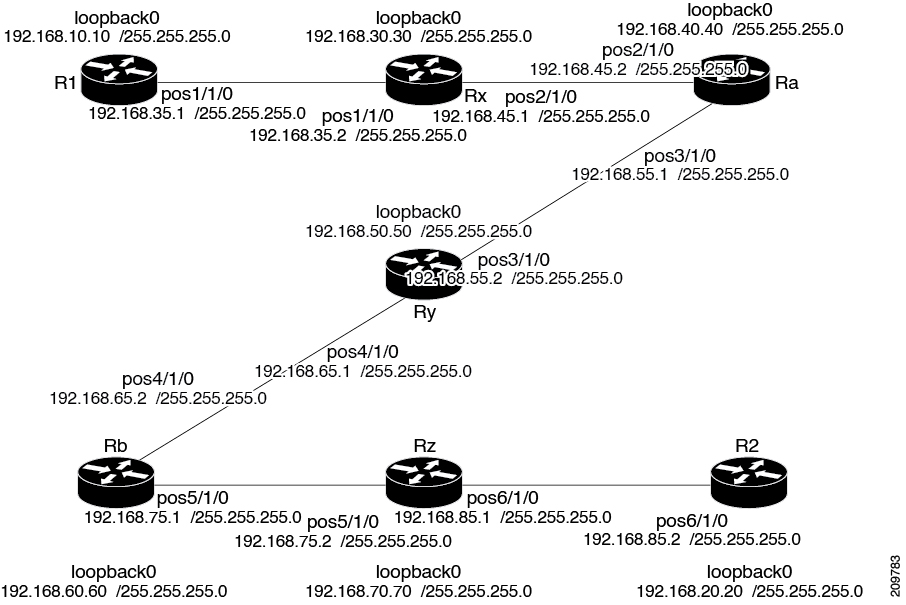ABR
--Area Border Router. A router connecting two areas. In OSPF, ABRs belong to both areas and must maintain separate topological databases for each.
When an OSPF router has interfaces in more than one area, it is an Area Border Router.
area
--A logical set of network segments (for example, one that is OSPF-based) and their attached devices. Areas usually are connected
to other areas by routers, making up a single autonomous system. OSPF and IS-IS define their areas differently. OSPF area
borders are marked by routers. Some interfaces are in one area, and other interfaces are in another area. With IS-IS, all
the routers are completely within an area, and the area borders are on links, not on routers. The routers that connect the
areas are level-2 routers, and routers that have no direct connectivity to another area are level-1 routers.
area
ID
--In an IS-IS router, this area address is associated with the entire router rather than an interface. A router can have up
to three area addresses. Both the area ID and the system ID are defined on an IS-IS router by a single address, the Network
Entry Title (NET).
autonomous
system
--A collection of networks under a common administration sharing a common routing strategy. Autonomous systems are subdivided
by areas.
Cisco
Express
Forwarding
--An advanced Layer 3 IP switching technology. Cisco Express Forwarding optimizes network performance and scalability for
networks that have large and dynamic traffic patterns, such as the Internet, and for networks characterized by intensive Web-based
applications or interactive sessions. Cisco Express Forwarding uses a Forwarding Information Base (FIB) to make IP destination
prefix-based switching decisions. The FIB is conceptually similar to a routing table or information base. When routing or
topology changes occur in the network, the IP routing table is updated, and those changes are reflected in the FIB. The FIB
maintains next-hop address information based on the information in the IP routing table.
headend
--The upstream, transmit end of a tunnel. The router that originates and maintains the traffic engineering LSP.
IGP
--Interior Gateway Protocol. Internet protocol used to exchange routing information within an autonomous system. Examples
of common IGPs include OSPF and Routing Information Protocol (RIP).
interarea
TE
--Ability for a traffic engineering LSP to span multiple areas.
IS-IS
--Intermediate System-to-Intermediate System. IS-IS is an OSI link-state hierarchical routing protocol based on DECnet Phase
V routing, where intermediate system (IS) routers exchange routing information based on a single metric to determine the network
topology.
label
switched
path
(LSP)
tunnel
--A configured connection between two routers in which label switching is used to carry the packets.
level-1
routers
--Routers that are directly connected to other areas. The routers are not in the backbone. MPLS does not run in the background.
These routers are also called internal routers.
level-2
routers
--Routers that connect two areas. These routers let you run MPLS in the background.
load
balancing
--The distribution of traffic among multiple paths to the same destination so that the router uses bandwidth efficiently.
Load balancing increases the use of network segments, thus increasing effective network bandwidth.
LSP
--label switched path. A sequence of hops such as R0...Rn in which a packet travels from R0 to Rn through label switching
mechanisms. A label switched path can be chosen dynamically, based on normal routing mechanisms, or through configuration.
mask
--A bit combination used to describe which part of an address refers to the network or the subnet and which part refers to
the host.
MPLS
--Multiprotocol Label Switching. A method for forwarding packets (frames) through a network. It enables routers at the edge
of a network to apply labels to packets. ATM switches or existing routers in the network core can switch packets according
to the labels with minimal lookup overhead.
OSPF
--Open Shortest Path First. Link-state, hierarchical IGP routing algorithm proposed as a successor to Routing Information
Protocol (RIP) in the Internet community. OSPF features include least-cost routing, multipath routing, and load balancing.
process
ID
--Distinguishes one process from another within the device. An OSPF process ID can be any positive integer, and it has no
significance outside the router on which it is configured.
router
ID
--Something by which a router originating a packet can be uniquely distinguished from all other routers. For example, an IP
address from one of the router’s interfaces.
static
routing
--A static route is a fixed path preprogrammed by a network administrator. Static routes cannot make use of routing protocols
and don’t self-update after receipt of routing update messages; they must be updated by hand.
tailend
--The downstream, receive end of a tunnel. The router that terminates the traffic engineering LSP.
traffic
engineering
--The techniques and processes that cause routed traffic to travel through the network on a path other than the one that would
have been chosen if standard routing methods were used.
tunnel
--A secure communication path between two peers, such as two routers. A traffic engineering tunnel is a label switched tunnel
that is used for traffic engineering. Such a tunnel is set up through means other than normal Layer 3 routing; it is used
to direct traffic over a path different from the one that Layer 3 routing could cause the tunnel to take.
virtual
link
--Ordinarily, each area is directly connected to area 0. A virtual link is used for a connection when an area is connected
to an area that is one area away from area 0.



 Feedback
Feedback